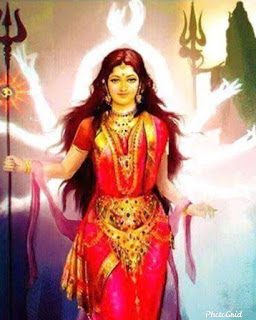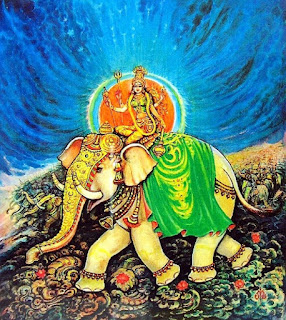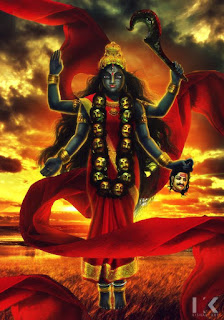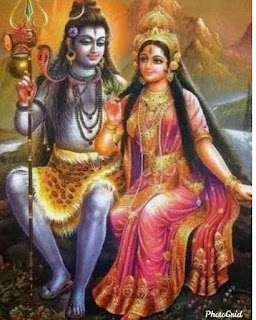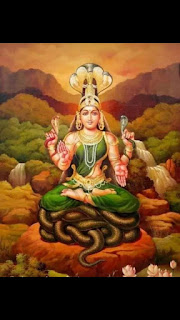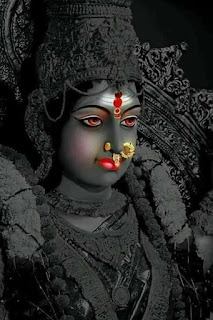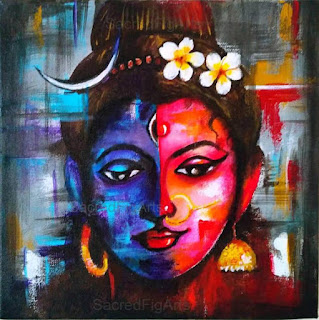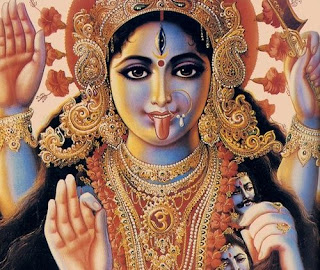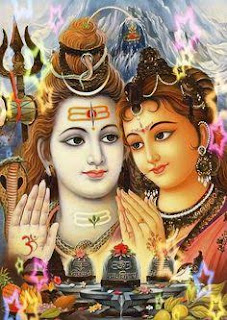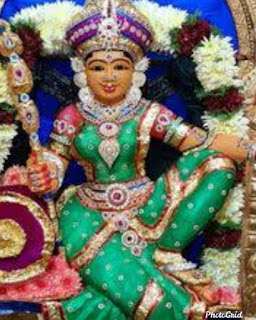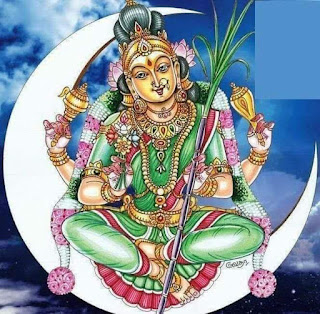From this nāma onwards till 111, the subtlest form of Lalitāmbikā, which is kuṇḍalinī, is discussed.
कुलामृतैक-रसिका (90)
Kulāmṛtaika-rasikā
कुलसङ्केत-पालिनी (91)
Kulasaṅketa-pālinī
She likes the taste of kulā, which means the nectar or the ambrosial essence that flows from the sahasrāra. When kuṇḍalinī reaches the crown cakra and conjoins with Śiva, a few drops of nectar like fluid, ambrosia flows into the throat. This is also called amṛta varśini.
कुलाङ्गना (92)
Kulāṅganā
कुलान्तस्था (93)
Kulāntasthā
कौलिनी (94)
Kaulinī
कुलयोगिनी (95)
Kulayoginī
She hails from a lineage whose women protect the honour of their families.
She is the subject of Kula, which means Śaktī. Śaktī prevails everywhere i.e. omnipresent.
She is the core of kaula worship. Kaula worship is a tantric worship under śākta method. Therefore she is called kaulīnī.
Kaulā also means mental worship through yogic methods. That is why she is called as Kulayoginī.
अकुला (96)
Akulā
समयान्तस्था (97)
Samayāntasthā
समयाचार-तत्परा (98)
Samayācāra-tatparā
She does not have genealogy, hence akula. She was created by Śiva and hence no parentage. Akula also means beyond kula.
She is the centre of samayā doctrine. Samayā means internal or mental worship. Mental worship is more powerful than external rituals.
Worshipping Lalitai in the cakra-s of kuṇḍalinī, beginning from mūlādhāra cakra is called samayācāra.
This type of mental worship can be done only upon initiation from a Guru.
मूलाधारैक-निलया (99)
Mūlādhāraika-nilayā
ब्रह्मग्रन्थि-विभेदिनी (100)
Brahmagranthi-vibhedini
She resides in mūlādhāra cakra. Mūla means root and ādhāra means support. That is why mūlādhāra cakra is called the base (foundational) cakra.
She pierces the brahma granthi. There are three knots called granthi-s in three places in the path of Kuṇḍalinī. These granthi-s are to be pierced to make the Kuṇḍalinī ascend to the higher cakra-s. First of such granthi-s is found above the mūlādhāra cakra and below the svādhiṣṭhāna cakra. Kuṇḍalinī has to pierce the brahma granthi to reach the svādhiṣṭhāna cakra.
मणिपूरान्त-रुदिता (101)
Maṇipūrāntha-ruditā
She is well decorated and seated on the throne in the manipuraks cakra.
Verse 40 of Soundarya Lahari speaks about the bow of lighting emanating from the manipuraka chakra.
It's said that in deep stage of meditation, one will be able to see bright light in the form of a bow.
विष्णुग्रन्थि-विभेदिनी (102)
Viṣṇugranthi-vibhedinī
She pierces the second knot called Viṣṇu granthi, which is just above the navel cakra. Lord Viṣṇu resides in maṇipūraka cakra and that is why the knot above this cakra is called Viṣṇu granthi.
आज्ञा-चक्रान्तरालस्था (103)
Ājñā-cakrāntarālasthā
रुद्रग्रन्थि-विभेदिनी (104)
Rudragranthi-vibhedinī
She resides in ājñā cakra which is also known as third eye. This is the last of the six cakra-s and this cakra belongs to one’s guru from where he gives his commands to the sādhaka. In this cakra, a sādhaka gains a little knowledge about the Brahman.
She breaks the Rudra granthi and proceeds to sahasrāra. This is the last of the three knots. Once this last granthi is passed over, all the vāsana-s (impressions) go away leading to supreme knowledge. Till this point Kuṇḍalinī had to cross too many resistances to reach Her final destination.
सहस्राराम्बुजारूढा (105)
Sahasrārambujārūḍhā
सुधासाराभि-वर्षिणी (106)
Sudhāsārabhi-varṣiṇī
She has now reached Her destination, the sahasrāra, where Śiva is waiting for Her. Sahasrāra is just below the brahmarandhra, an orifice in the skull that connects to cosmos (The existence of this orifice has not been medically proved. Perhaps this is like the pores that exist in our skin through which sweat comes out. But one can distinctly feel the cosmic connection through this orifice). The union of Śiva and Śaktī takes place at sahasrāra.
There is one soma chakra in the middle of sahasrāra. When Kuṇḍalinī reaches this cakra, out of the heat generated by Her presence, the ambrosia which is stored there gets melted and drips through the throat and enters the entire nervous system.
तडिल्लता-समरुचिः (107)
Taḍillatā -samaruciḥ
षट्चक्रोपरि-सम्स्थिता (108)
Ṣaṭcakropari-samsthitā
She shines like a line of lightning. In the advanced stage of Kuṇḍalinī meditation, one can realize the entire spinal cord glowing like a flash of lightning. She shines like a lightning when She is with Śiva.
She is above the six cakra-s starting from mūlādhāra to ājñā cakra-s. She is now at sahasrāra, which is not a cakra. To realise the Brahman in sahasrāra, one has to cross the lower cakra-s, all of which are associated with worldly acts. Sahasrāra is above the worldly acts. That is why She is said to be above these six cakra-s, meaning that the Brahman is above the six cakra-s.
महासक्तिः (109)
Mahāsaktiḥ
Maha means festivals and asaktiḥ means great liking. She has a great liking for festivities. Maha also means supremacy, "ā" means on all sides and Śaktī means supreme. Her supreme power is spread across everywhere.
कुण्डलिनी (110)
Kuṇḍalinī
She is in the form of a three and a half coiled snake in mūlādhāra cakra. Her subtlest form is described in this single nāma. The vital energy of prāṇa is called kuṇḍalinī. This lies in the mūlādhāra cakra in the midst of fire that keeps biological body warm. Any modification in the intensity of this fire causes sickness. The sound of the Kuṇḍalinī can be felt by anyone. If one closes both his ears tightly, he can listen to a hissing sound, the sound of Kuṇḍalinī from within.
बिसतन्तु-तनीयसी (111)
Bisatantu-tanīyasī
She is like the minute fibre of a lotus stalk. This is the last of the nāma-s that describe Her subtlest form. She is like a young girl in the lower cakra-s as She makes sound in the mūlādhārā cakra, gets dressed like a bride in the navel cakra and proceeds to meet her spouse Śiva in sahasrāra.
With this nāma the description of Her Kuṇḍalinī form ends and from the next nāma, the description of Her blessings begin.


